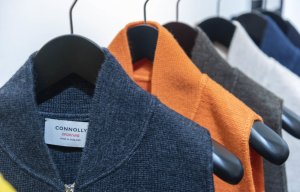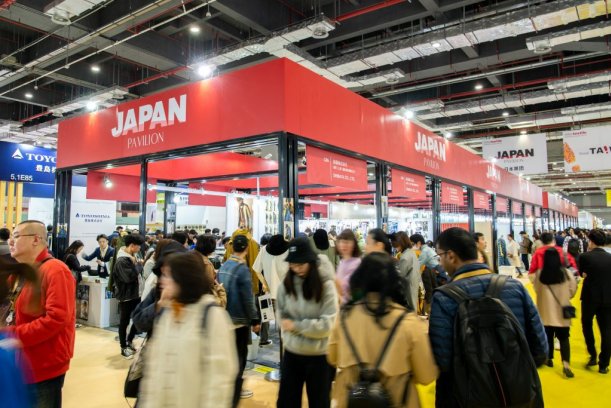
Good Vibrations at Pitti Uomo
Made in Japan is a popular selling point across many consumer goods categories in China, and this demand extends to the apparel textiles industry.

9th May 2019
Knitting Industry
|
Shanghai
The most recent Japan Pavilion drew large crowds at Intertextile Shanghai. © Intertextile Shanghai
Made in Japan is a popular selling point across many consumer goods categories in China, and this demand extends to the apparel textiles industry. The Japan Pavilion is now well established at both Intertextile Pavilion Shenzhen and Intertextile Shanghai Apparel Fabrics and continues to draw large crowds at every edition of both fairs.
“In this edition, we’ve met a good number of Chinese fashion brands,” noted Rio Okabe, General Manager of Toyoshima’s Global Operations Department at the 2019 Spring Edition of Intertextile Shanghai. “There’s big potential in this show, and every time, we can meet more than 500 visitors here. No matter what, people and opportunities are still coming to Intertextile. The demand is still really strong here.”
Iwashita Yuichi, Director of the Shanghai branch of the daily textile newspaper Sen-i-News, shared a few reasons for the popularity of Japanese textile suppliers in China: upgraded consumption habits from Chinese consumers, as well as recognition of craftsmanship, flexible order services and reliability.
Chinese ladies wear and designer brands are keen to source unique fabrics that differentiate their products in the saturated market. Chinese brands often move towards Italian and Japanese fabrics to achieve this.
“In Shenzhen and Guangzhou there are many new brands looking for Japanese products, and this fair is one of the most important in the industry so these brands will attend,” observed Ken Kanatani, Fabric Division Manager of STYLEM Intl (HK), at Intertextile Pavilion Shenzhen 2018. “In the last four years, the Chinese market has changed. Buyers don’t just want mainstream products – they want trendy and unique items, and they want them quickly so they can stay ahead of the trends.”
The advantages of Japanese printing, dyeing and special processing are not based on equipment, but on the spirit of traditional craftsmanship that is passed down through generations, creating fabrics that are truly unique to Japan – a major selling point in China. As well as this, certain fibres are distinctively Japanese.
Triacetate is exclusively produced by Mitsubishi Chemical as its Soalon brand, and Cupro fibre is exclusively produced by Asahi Kasei as its Bemberg brand. In the past, these two companies have used Intertextile as a platform to promote their fibre brands in China. Fabrics made using these unique fibres are extremely popular amongst high-end Chinese brands, especially ladies wear in Shenzhen.
Japanese suppliers specialise in handling quick delivery, small quantity orders and product-in-stock services. This suits large Chinese brands with stocking pressures, who tend to display smaller collections in stores and only mass-produce more popular items, as well as smaller designers who use less fabric to start with.
“There are around 6,000 designer brands in China, including start-up brands who understand quality, but can only afford small-quantity orders to start with. Many are located in Shenzhen. However, they have strong potential to grow into bigger enterprises in the future and will be able to buy more from us then. Therefore, being at this fair is a valuable investment,” commented Suetaka Yasuda, President of STYLEM, at Intertextile Pavilion Shenzhen 2017.
Japanese customer service is recognised by Chinese brands as being trustworthy. Production timelines are reliably met without delay, while Japanese companies will also take responsibility for any problems with products and make a strong effort to find solutions.
At Intertextile Pavilion Shenzhen 2018, both domestic and overseas buyers noted their need for smaller, faster orders in today’s fashion industry. “In the past, we used to source all the fabrics we need in the beginning of the season, but now, we have divided the seasons so that we are more responsive to the market trends. Therefore, we often look for suppliers that accept small quantity orders. We have been sourcing more from the Japanese companies,” explained Anne Chou, Creative Director of Design Esta Studio, Macau.
More crowds are expected at the next edition of Intertextile Pavilion Shenzhen in July, a prime platform for Japanese exhibitors looking to meet high-end Chinese fashion brands, as well as high-quality overseas trade buyers. Highlighted exhibitors in the Japan Pavilion include Kokka, Sojitz, Stylem, Sun Fashion, Sunwell, Uni Textile and Yonezawa.

Business intelligence for the fibre, textiles and apparel industries: technologies, innovations, markets, investments, trade policy, sourcing, strategy...
Find out more